THE LANCASTER'S ELECTRICAL SYSTEM
This section summarizes the electrical installation and the positions of the main electrical power sources and components in the Lancaster aircraft.The system consists of four, engine driven generators connected in parallel and two 12 volt batteries in series supplying a positive feed to a number of panels, distribution boxes and junction boxes. There is also a grounded negative network of eight master grounding wires which ground separate groups of services. The wiring between components is mainly sheathed in flexible conduit or metal braided cables. Identification numbers on conduits for general services are prefixed with the letters F for fuselage, P for port mainplane and S for starboard mainplane.
DC Power Supply and Distribution
DC power is supplied from four engine driven generators which charge two 12 volt 88 ampere hour batteries connected in series, the sum of which provides a 24 volt, 88 ampere hour supply for the general services. One, type "KX", self excited, four-pole, shunt-wound generator is mounted on each inboard engine and one, type "UO", dual purpose generator is mounted on each outboard engine. The type KX generators have full-load outputs of 29 volts at 60 amperes. Current control is provided by type F voltage regulators and type D cut-outs, mounted in the base of the main distribution panel, which also regulates the output at 28 VDC +/- 0.5 volts. The type UO generator is a dual purpose device supplying both AC and DC outputs. Full load DC output for each is 30 volts at 100 amperes. Output voltage is controlled at 28 VDC +/- 0.5 volts by carbon pile regulators acting on the shunt field winding of the DC section of the generator. Generator field switches and circuit breakers for the charging circuits are provided. Those for the type KX generators are on the main distribution panel and those for the UO generators on the Martin turret panel. At the front of each engine fireproof bulkhead, connected in series with the generator, is a noise suppressor to reduce the level of radio interference.
On the starboard side of the fuselage, mounted between the spars, is a main electrical switch which permits the selection of power supply to the aircraft services from either the aircraft's batteries or an external power source. When the switch is in the "GROUND" position, the aircraft supply is disconnected and power must be supplied from external batteries or an external generator. When the switch is in the FLIGHT position, all services are energized from the aircraft's electrical supply. When in this position, the generators may be isolated by means of the field switches.
Main Distribution Panel
The main distribution panel is mounted on the starboard side of the fuselage immediately forward of the front spar. The interior of the panel serves as a main distribution junction box and contains 52 general service isolating circuit breakers. The following components are mounted on the panel:
* Two ammeters to register charging rates of inboard engine generators.
* Two inboard generator field switches.
* Two circuit breakers for KX generator charging circuit.
* One de-icing master switch.
* One radio master circuit breaker.
* One battery voltage indicator.
* One wing tip recognition light selector switch.
* One head or station light selector switch.
* 52 general service circuit breakers.
* Automatic cut-outs and voltage regulators for the KX generators.Nine general service boxes are installed in the aircraft and are identified by the prefix JB.
1200 Cycle AC Power Supply
Alternating current is supplied for the operation of specialized equipment. This supply is provided by the AC sections of the UO type generators mounted on the outboard engines. Full load output of the alternators is 80 volts at 15 amperes at a frequency of 1200 to 2400 cycles with the nominal frequency being 1,200 cycles per second at 3000 (generator) rpm. Power from this alternator is supplied to an alternator plug panel mounted on the port bulkhead forward of the navigator's table.
400 Cycle AC Supply
Two Jack & Heintz F16 inverters are fitted on the starboard side of the fuselage between formers 9 and 10. No. 1 inverter is mounted on the fuselage floor and No 2 is attached to the fuselage structure immediately above No.1. Each inverter is capable of providing 115 VAC, 400 cycle, 250 VA when operated on an input of 26 to 29 VDC. A cautionary note on the inverters instructed the user not to use them continuously. Alternate selection between the two inverters should be made at regular intervals. In practice, this was not followed because the Navigation section complained about power interruption to their B3 drift meters when the inverters were cycled.
AUXILIARY POWER UNIT (APU)
The APU is installed on the starboard side of the aircraft and is attached to two top-hat section stringers which are bolted to the upper flanges of the tailplane spars. The APU uses a single cylinder, air cooled, two-stroke engine driving a generator which is connected to the engine's crankshaft. Charging output is at 27 volts at 87.7 amperes DC for all ground running purposes. A control box at the forward end of the APU incorporates a voltmeter and an equalizing switch.
EXTERNAL POWER SOURCE
During ground servicing operations, power may be supplied to the aircraft services from an external source. A socket type connector is installed in each inboard nacelle to connect the aircraft services to an external battery or portable generator supply. Two types of connector sockets are used; that in the port nacelle being of the British two prong type. An American style three prong AN type socket is installed in the starboard nacelle. This arrangement permits the use of either British or American type ground equipment.
DESCRIPTION OF ELECTRONICS
Variants
10S = Standard version
10MR = Maritime Reconnaissance
10MP = Maritime Patrol
10N = Navigation Trainer
10P = Photographic Reconnaissance
TACTICAL DEVICE USED ON DESCRIPTION H2S Mk 2D MR, S WWII era search radar. Initially it operated in the 10 cm band using the CV64 magnetron but in later versions the wavelength was first reduced to 3 cm and then to 1.5 cm. Its service life spanned from 1943 to the 1990's. Mk 2D, the one installed in the 10MR operated on a wavelength of 9.1 cm. The 10MR Lancs only used the 10 cm version. AN/APS-33 MP X-Band Search Radar. It replaced H2S radar in the 10MP variant. Transmitter: 9,375 MHz plus or minus 55 MHz. Peak RF Power Output: 52 kw minimum. Range up to 200 nm. Uses the AS-289A/APS-33 antenna whose dome was like a 20 gallon cylindrical drum tank hanging straight down from the fuselage. It came in five variants: AN/APS-33 (Type I) ; AN/APS-33A (Type II); AN/APS-33C (Type III); AN/APS-33D (Type IV); AN/APS-33F (Type V). It is not known at this time as to which variant was fitted on the 10MP Lancaster but likely it was the first type. The APS-33 dome did not retract.
AN/APS-33 system components (Courtesy Tpub.com)
AN/UPD-501 MP High Probability Radar Early Warning directional finding receiver. Fitted towards the end of the Lanc's service life. See receiver/display photo below table. AN/CRT-1 MR/MP Sonobuoy system. AN/ASR-3 MR/MP Diesel submarine exhaust gas detection system, nicknamed “Sniffer”. The sensor is based on technology developed by the Royal Navy during WWII and had a fairly short detection range. Nonetheless, it was surprisingly valuable up until the 1980s. Many airborne naval radars lacked the definition to pick up a snorkel (especially in rough seas) so it was entirely possible to fly right over a snorkeling sub, especially at night. SCR-695 MR/MP IFF Set, Mark III operating on the I and G-Bands. See detailed explanation elsewhere in this document. Model 22N MR/MP Pierce Wire recorder. Used to preserve proof of detection and kill when used in conjunction with the sonobuoy receiver. It recorded the output of the sonobuoy receiver and the interphone conversations. COMMUNICATIONS DEVICE USED ON DESCRIPTION BC-348 MR/MP HF "Liason" receiver. Frequency coverage 190 - 500 KHz and 1.5 to 18 MHz. This receiver could only be controlled locally. Requires 28 VDC, 56 watts. See photo below table. ART-13 MR/MP Collins autotune HF transmitter used for Liason communications. Frequency range 1.5 to 18 MHz and 200 to 600 KHz . Modes: CW, MCW and AM. It has ten autotuned preset channels on HF and one on LF. Power output varies between 65 and 90 watts depending on frequency. Input power 780 watts. The transmitter is coupled to the trailing wire antenna by a CU-25 antenna loading unit. See Radio Ops position photo below table. SCR-274N MR/MP HF "Command" transmitter/receiver radio system. Click on link for photos and a more detailed explanation. SCR-522 MR/MP The SCR-522 was a voice only, VHF transmitter/receiver operating in the 100 to 156 MHz band with a power input of 8 to 9 watts. Operation was provided on any one of four crystal controlled channels. Integrally mounted in a common case, was the BC-624A VHF receiver and the BC- 625A VHF transmitter. The rest of the system consisted of 28 VDC input dynamotor (PE-94-A) and various jack and junction boxes. Input power consumption was 311 watts. Remote control of the radio is provided by a channel selector box located in the cockpit. The SCR-522 is also duplicated for redundancy in the 10MR and 10MP. External view of SCR-522 with pilot's remote control box.
(Photo by Jerry Proc)
Internal view of SCR-522 sitting atop its case.
(Photo by Jerry Proc)3611B MR/MP Interphone Amplifier. A two-stage, high gain amplifier which provides interphone facilities for all crew members. It supports the use of carbon or dynamic microphones. Output power is 3 watts. MI-22A MR/MP Station box. These provided simultaneous communications facilities for all crew members. Individual crew members employed the desired system without interference from one another except when CALL was used. This would override all services. RL-42 MR/MP HF Trailing Wire Antenna. The trailing wire antenna winch RL-42 was controlled from a reel control box BC-461. Contained on the reel was 290 feet of wire connected through a fairlead to a five pound lead weight. Every turn of the reel represented 1 foot of antenna. A counter, connected to the reel, indicated how many feet of wire were extended. A changeover switch allowed the trailing wire antenna to be shared between the Loran navigation set and the ART13/BC348 Liaison radio. Drive motor and reel. (Photo courtesy Consolidated Aircraft, circa 1943)
NAVIGATION DEVICE USED ON DESCRIPTION SCR-718 MR/MP,
10N, 10PRadar Altimeter (High). 50 ft. to 40,000 ft. Accuracy ± 50 ft. plus 0.25%. Operates on 420-450 MHz. Consists of a BC-788-A transmitter-receiver, I-152-C indicator calibrated directly in feet and the AT-4/ARN-1 antenna. Transmitting and receiving antennas used by this equipment are also part of the low altimeter system. Operates on primary power source of 115 VAC. Power consumption of the radio set is 135 watts. Circa 1943. System components (Courtesy History.Navy.com)
AN/APN-1 MR/MP,
10N, 10PRadar Altimeter (Low). Ranges: 0-400 and 0-4,000 feet. Operates on 420-460 MHz. Uses Doppler frequency shift. Circa 1943. Consists of a transmitter/receiver RT-7/ARN-1, altitude indicator ID-14/APN-1, altitude limit switch SA-1/APN-1, antenna assembly AT-4/APN-1, antenna relay type RCA-AVA/68 and a dummy plug. Power input 75 watts. The altitude indicator incorporates a shutter device to control the double range dial of 0-400 feet and 0-4000 feet. The limit switch determines the altitude at which the limit indicator operates, with the scale calibrated directly in feet on the low range and multiplied by ten on the high range. Three lights, green, red and amber, comprising the limit indicator, illuminate and indicate the relative altitude of the aircraft with respect to the setting of the limit switch.
The antennas used with the low altimeter are also part of the high altimeter system. The assembly consists of two dipole antennas, located on the under-surface of the wings between the inboard engines and the fuselage. The antenna relay, RCA-AVA/6B, which transfers the antennas to the required system, is controlled by switch mounted on JBR No 1.
APN-1 Tx/Rx only. (Photo courtesy Kurrajong Radio Museum)
APN-1 system components (Courtesy T-pub.com)AN/APN-4 MR/MP,
10NThe AN/APN-4 is an airborne Loran 'A' navigational aid employed to determine the geographical location of the aircraft in relation to several ground based Loran-A stations. This installation comprises a receiver (R-9A/APN-4) and an indicator (ID-6/APN-4) The plotted data obtained from the indicator gives the location in degrees of latitude and longitude. The receiver operates on four channels preset at frequencies ranging from 1.6 to 3.3 MHz and 7.58 to 11.75 MHz. A channel selector is provided on the receiver for selection of the desired frequency. The controls for the equipment are mounted on the front panels of the indicator and receiver This equipment utilizes the liaison fixed or trailing wire antennas. Maximum power draw is 270 VA.
Loran 'A' ID-6 display-only. (Photo by Jerry Proc)
AN/APN-2 MR/MP, 10N, 10P The AN/APN-2 "REBECCA" is a blind homing and approach aid used by the navigator to obtain the relative location of a co-ordinated ground beacon stations. The system comprises a transmitter -receiver, ATT1/APN-2, indicator, BX-929-A, control box, C-3/APN-2, remote tuning unit, C-134/APN, tuning adaptor, MX-196/APN, two receiving dipole antennae (AN148) and one transmitting whip antenna. The transmitter-receiver unit transmits RF pulses to a ground station and receives an answering pulse. The received signal appears on the cathode-ray tube display of the indicator as a visual representation of the distance and direction of the answering station in reference to the line of flight. The receiver operated on two pre-set frequencies spaced by 5 MHz in the range of 214 to 234 MHz.
The transmitter operated on five pre-set channels at frequencies of 214, 219, 224, 229 and 234 MHz.. An antenna filter, type F-65-A, is connected in the transmitter antenna co-axial feeder to prevent interference with the IFF system.
This equipment operated from the aircraft's primary 28 VDC and 80 VAC power mains; the total power requirement was 25 watts and 180 VA respectively.
BC929 indicator unit. (PE1NGZ Signals Collection '40-'45)
AN148 antenna (PE1NGZ Signals Collection '40-'45)AN/ARD-3 MR/MP Direction finding set. Manufactured by Collins. Circa 1944. Need photo. MN-53B MR/MP Marker receiver. Made by Bendix Radio, Baltimore. Used to receive a beacon signal on 75 MHz. It provided aural and visual identification of airways, outer or inner markers, each of which had its own distinguishing modulation tone of 3,000, 400 or 1,300 Hz respectively. AN/ARN-6 MR/MP Radio Compass. 150 to 1750 KHz. Being dual controlled, it could be operated by the pilot or navigator. OTHER AN/ASA-3 MR/MP Static Discharger. They were provided to reduce radio interference caused by the accumulation of static electricity on the aircraft structure. The discharger consists of a 13 inch conducting cotton wick enclosed in a plastic sheath. One and a half inches of the wick extend from the open end of the sheath. The other end is enclosed in a metallic tube which is flattened on the end and provided with two mounting holes. Four dischargers are mounted on the trailing edge of each wing and three are mounted on the trailing edge of each rudder. DR MR/MP Compass (British) AMU, API and GPI MR/MP Ground and AP position indicators. F.24 MR/MP The Williamson F.24 camera was a day/night camera employing a 5" x 5" negative format. It was the main air reconnaissance camera at the start of WWII and was available in 4, 5, 8 and 20 inch focal lengths. Pictured in the link is a camera with an 8 inch focal length.
ANTENNA SYSTEMS
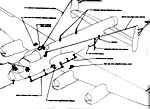 |
Antenna systems of the 10 MR and 10MP Lancaster. Not shown are the static dischargers located on the wingtips. Click to enlarge. (Extract from EO 05-25A-2) |
LOCATION AND IDENTIFICATION OF ELECTRONICS
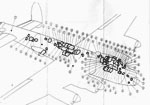 |
It has been said that the Argus (CP107) was a flying electronics warehouse. The Lancaster MR/MP can certainly challenge that distinction. Click either thumbnail to enlarge. (Extract from EO 05-25A-2) |  |
FEATURED EQUIPMENT
AN/APS-33 RADAR and AN/UPD501 ANTENNAS
 |
| The UPD-501 and APS-33 antennas show up well on RX-159, a 10MP variant. (Photo by Prestwick Hayden Hurst) |
ART-13 TRANSMITTER/BC-348 RECEIVER
 |
| A BC-348 receiver (bottom) and ART-13 transmitter (top) at the radio operator's position of this Canadian-built Lancaster. (Photo from the collection of Hu Filleul) |
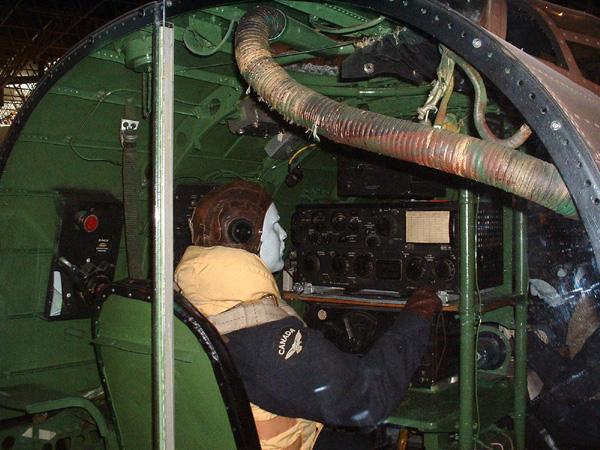 |
| This display of a Canadian Lancaster radio operator's station is part of the collection of the Canada Aviation Museum, Ottawa, formerly called the National Aeronautical Collection. (Photo by Jerry Proc) |
SCR-695 IFFThe SCR-695 is a Mark III IFF transponder. It receives challenge signals from a ground station and transmits coded replies to identify the aircraft as friendly. This installation comprises of a transponder, BC-966A, power control box, BC-958A, selector control box, BC-965A, antenna assembly, AN-950A, and a destructor system.
The transponder operates within the frequency range of 157 to 187 MHz in the ' I ' band, and 194 to 211 MHz in the 'G' band. On the ' I ' band, the transmitter is pre-set to permit the transmission of six differently coded replies; the 'G' band replies are non-coded. Selection of any coded transmission is made possible by the selector control box.
A power control box is provided with an EMERGENCY switch which is operated when the aircraft is in distress. The EMERGENCY reply to any challenge signal consists of a distinctive code, giving an immediate indication that the aircraft is in difficulty. The phone jack on this unit permits the use of headphones, to enable a rough check of the operation of the equipment. The ON-OFF switch controls the input power to the dynamotor in the transponder. An ON-OFF switch located on the pilot's auxiliary panel, and an EMERGENCY 'F' switch on the pilot's instrument panel provide the pilot with a remote control of the equipment.
The destructor unit is an electrically operated detonator which will destroy the transponder to the extent that it cannot be utilized by the enemy. The destructor control system consists of an impact switch, isolating switch, warning lights and three push-button type switches. The circuit is energized by depressing the push-button switches on the navigator's panel, at the radio operator's station or on the pilot's instrument panel. The impact switch located on former G (fuselage structural member) , starboard side, also energizes the detonator circuit when the SAFE-LIVE switch on the navigator's panel is in the LIVE position.
AN/UPD-501
The UPD-501 was a High Probability Radar Early Warning directional finding receiver which was used to detect radar emissions on the SHF radar bands and gave some indication of the frequency in use, bearing, and the antenna rotation period. It was introduced late in the service life of the Lancaster MR.
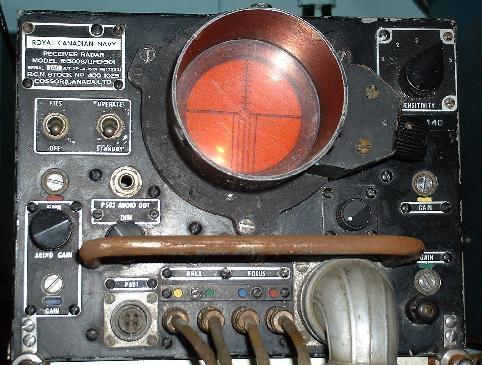 |
| AN/UPD-501 receiver. The system was made by Cossor Canada Ltd. (Photo by Jerry Proc) |
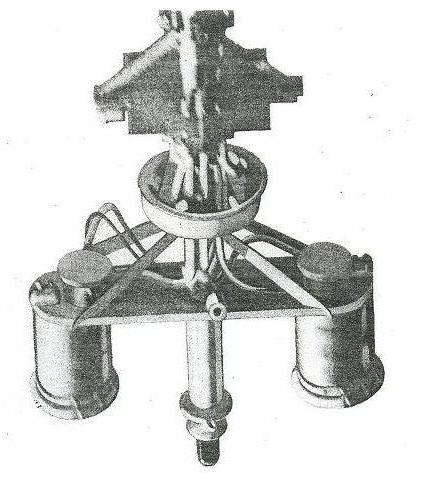 |
| Airborne version of the UPD-501 antenna with radome removed. (Photo courtesy RCN) |
This device was the outcome of a project initiated by Naval Headquarters, and was a contemporary of the early Magnetic Anomaly Detector (MAD) work. It was a wide-band dual-band electronic countermeasures (ECM) receiver system. This project was started in the early 1950s by the National Research Council who undertook to develop "a simple ‘instantaneous’ direction-finding receiver-display for detection of non co-operative radar transmissions expected to be of short duration". It was designed to listen for radar emissions from submarines, surface vessels and even aircraft.AN/ASR-3
The AN/ASR-3 detected particulate matter from diesel exhaust. It took in an air sample, analyzed it and gave a visual and aural indication. It could be set for "sensitivity" and would produce an "in trail" and "out of trail" mark that the crew would plot, then reverse course to re-enter the trail gaining additional "marks." Eventually the navigator plotted a rough course to the target.
Not only would it detect a snorting sub, it would also detect destroyers, merchant ships, fishing boats, and the entire East or west coast of North America. In other words, whatever value it had in open ocean conditions was quickly lost as the aircraft approached crowded waters or pollution filled urban areas.
AN/ARN-5 ILS SYSTEM
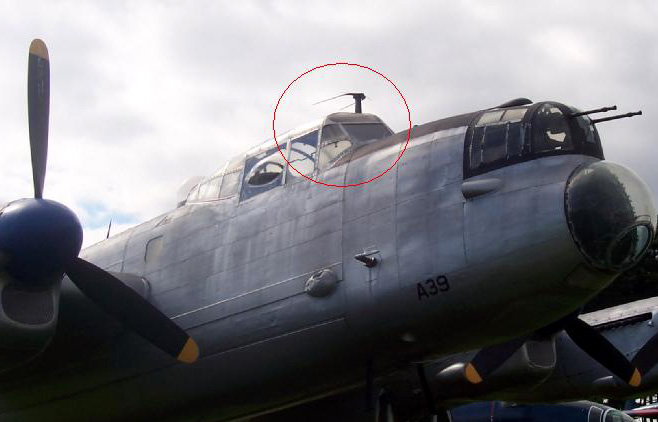 |
| This Lancaster 10MP, held in the collection of the Greenwood Aviation Museum, sports an antenna for the AN/ARN-5 Instrument Landing System receiver. This device was not found in the Lancaster equipment manifest so perhaps it was limited to aircraft which operated from bases which had an ILS facility such as 408 Sqn. None of Lancasters in 2(M)OTU or 407 Sqn had them (Photo by Ian MacCorquodale, Mac's Naval Photography) |
AN/APN-2 "REBECCA/EUREKA"Rebecca /Eureka was a simple system designed initially to assist with the delivery of supplies to the Allied Armies or Resistance groups in occupied Europe during WWII. Rebecca was the airborne portion while Eureka was the ground based portion. The original system was effective only to within two miles at which time the crew had to switch to visual means of locating the drop zone. Reliance on Rebecca without visual confirmation invariably resulted in premature drops as occurred during the American airborne landings in Normandy. The system eventually expanded into blind homing and approach aid for aircraft. The Rebecca code name was derived from the phrase "recognition of beacons".
The ground based Eureka beacon complete with its aerial was air-dropped and assembled on the drop zone. The Eureka transponder was based on a super-regenerative receiver with a separate transmitter tube and powered by a battery operated vibrator supply. A coding unit which was part of the Eureka beacon provided an identification signal and also permitted it to send simple Morse Code messages by periodically varying the width of the beacon response pulses.
Airborne Rebecca equipment radiated 5 microsecond wide interrogating pulses about 300 times a second.
on a single frequency. On receipt of the interrogating pulses, the Eureka beacon located on the ground triggered its associated transmitter causing responses to be radiated on a different frequency but at the same pulse recurrence frequency of the interrogating transmitter. The returned signal, received on both the right and left Rebecca receiver aerials, was displayed on a cathode ray tube in which the time-base was synchronized with the original pulse from the Rebecca transmitter and applied to the Y-plates of the cathode ray tube. The received signals were switched into the receiver in synchronism with the switching of the video-frequency output signals to the right and left hand X-plates of the cathode ray tube. In this way, if the beacon was to the right, the signal to the right of the time base will have a greater amplitude, in which case a right turn will be necessary to make the signals display equally in amplitude on either side of the time. Then the aircraft will then be flying directly towards the beacon.Early models of the system were limited to a single frequency. Later ones could switch between five frequencies.
Eureka Mk VII was a rack mounted, non-mobile transponder used at RAF bases for aircraft to home onto.The Mark X version of both Rebecca/Eureka worked in the 1000 MHz range. This was developed for use during in-flight refueling, enabling the receiving aircraft to locate the tanker while maintaining radio silence. The Tanker aircraft carried the Eureka and the receiving aircraft carried the Rebecca. This equipment was trialled in the early 1960's.
Credits and References:1) Hu Filleul <hufilleul(at)shaw.ca>
2) Canadian Aircraft Since 1909. Molson and Taylor.
3) Leo Pettipas <lpettip(at)mts.net> Associate Air Force Historian. Air Force Heritage and History 1 Canadian Air Division.
Winnipeg, Manitoba.
4) Lancaster engineering manual EO 05-25A-2 dated 30 August 1957
5) John Phillips <johnph(at)xplornet.com>
6) SCR-718 info: http://www.gordon.army.mil/ocos/museum/scrcomponents/scrPart4.asp#SCR-718
7) F24 camera. http://www.airrecce.co.uk/cameras/raf_ww2_cameras.html
8) PE1NGZ Signals Collection '40-'45
9) APN-2 info http://www.qsl.net/pe1ngz/airforce/airforce-raf/raf-eureka-rebecca.html
10) AN/ASR-3 info : http://www.harpoondatabases.com/encyclopedia/Entry1650.aspx
11) SCR-718 images. http://www.history.navy.mil/library/online/radar-12.htm
12) http://en.wikipedia.org/wiki/Eureka_beacon
13) http://www.qsl.net/pe1ngz/airforce/airforce-raf/raf-eureka-rebecca.html
14) http://www.duxfordradiosociety.org/equiphist/reb-eureka/reb-eureka-hist.html
15) Surplus Conversion Handbook by Tom Kneitel. Cowan Publishing. 1964
16) SCR 695 http://www.gordon.army.mil/ocos/museum/scrcomponents/scrPart4.asp
17) Duke Dawe <dukegm(at)shaw.ca>
18) Mac's Naval Photography http://macsnavylinks.ca/whatsnew.html
Nov 24/09